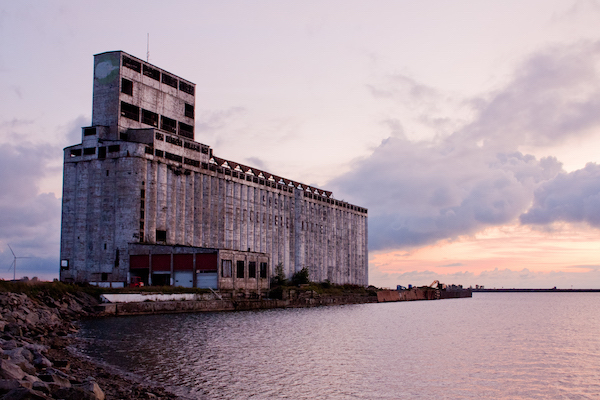When the Erie Canal opened in 1825, it quickly transformed the transportation of grain and other staple goods between the country’s coastal ports and interior regions to the west. The canal system greatly lowered the cost of shipping between the Midwest and the Northeast and almost immediately increased trade throughout the nation by opening eastern and overseas markets to Midwestern farm products. After it was built, the amount of grain received each year in Buffalo had risen from 112,000 bushels to 2 million in fewer than ten years.
In the Erie’s early days, grain was usually handled in bags. A full team of dockworkers could handle at most around 2,000 bushels a day, and that was only if the weather was cooperative. Loading or unloading a full ship could oftentimes take days. As Buffalo’s ports began handling ever greater quantities of grain-particularly wheat-and the port facilities became increasingly clogged. In turn, more shippers began sending grain down the Mississippi to avoid the overrun canal system, making it clear that the antiquated system was not sustainable.
Around 1841, a Buffalo grain merchant named Joseph Dart conceived the idea of applying mechanized conveying to transfer grain from freight ships. His inspiration came from the milling industry which had adopted an automated process developed by inventor Oliver Evans nearly fifty years earlier. Dart enlisted the help of Robert Dunbar, a Scottish immigrant who came from a long family line of engineers. He was actually in the business of flour mill construction when Dart presented him with his idea for a mechanical system of belts with buckets attached to scoop up the grain from the hulls of boats and put into storage.
The partnership resulted in “Dart’s Elevator,” the first steam-powered grain elevator in the world. It was seven times faster than the nonmechanized systems that came before it, allowing Buffalo to keep pace with America’s growing agricultural bounty. Within fifteen years, Buffalo had become the world’s largest grain port. The boom was fueled by 43 grain elevators that could transfer 4,000,000 bushels of grain in a 24-hour period using Dart’s concept and almost all constructed by Dunbar.
The world’s second and third grain elevators were built in Toledo, Ohio, and Brooklyn, New York, in 1847. These fledgling American cities were connected through an emerging international grain trade of unprecedented proportions. Grain shipments from farms in Ohio were loaded onto ships by elevators at Toledo; these ships were unloaded by elevators at Buffalo that shipped their grain to canal boats (and, later, rail cars), which were unloaded by elevators in Brooklyn, where the grain was either distributed to East Coast flour mills or loaded for further shipment to England, the Netherlands, or Germany. Through this loop of productivity set in motion by the invention of the grain elevator, the United States became a major international producer of wheat, corn, and oats.
Because of the money to be made in grain production, increasing numbers of immigrants in Brooklyn came to Ohio, Indiana, and Illinois to become farmers. More farmers meant more prairies turned into farmlands, which in turn meant increased grain production, which of course meant that more grain elevators would have to be built.
As the application of the new grain transfer system caught on across the country, it affected how storage buildings were designed and built. The conveyor systems permitted the transfer of grain to bins separated by a distance, where before they had to be close to each other. The layout of conveying equipment also had an effect on the architecture of the elevator building. The classic high cupola grain storage building became typical, creating the “Prairie Skyscrapers” that still dot rural America.
Many of the country’s early grain elevators, all built from wood, fell prey to fire. Combustion could suddenly occur from overheated grain, or from grain dust explosions, especially when grain was being loaded or unloaded from the elevator. In the 1890s, engineers began to seriously explore the use of fireproof materials in the construction of grain elevators. There were once 6,000 grain elevators across the prairies, built along rail lines by smaller firms and farmer-owned cooperatives from the 1920s to 1940s. By the time the 1970s rolled around, these old-style country elevators were being phased out, however.
As farms grew larger and more mechanized, the rural population began shifting to the city, resulting in the closure of many small-town businesses. With fewer potential passengers and freight, the rail companies began to re-evaluate certain lines, often finding it necessary to abandon them and subsequently remove the tracks. Those rail lines that continued to operate had to be competitive with highway and water transportation. Operators found that one large concrete facility, strategically located along the tracks outside township limits, could replace eight to fifteen old wood elevators. In many cases grain companies chose to demolish the old structure rather than sell it, thus creating a competitor.
Today, Buffalo, New York, remains not only the birthplace of the modern grain elevator, but it is also the American city with the single largest number of existing grain elevators. History buffs today can visit “Elevator Alley,” a section of the Buffalo River with the largest cluster of historic grain elevators in the world. A couple of companies even run kayak tours along the stretch! (Sources: Kansas Historical Society, Oklahoma Historical Society, Wiki, HMDB)










